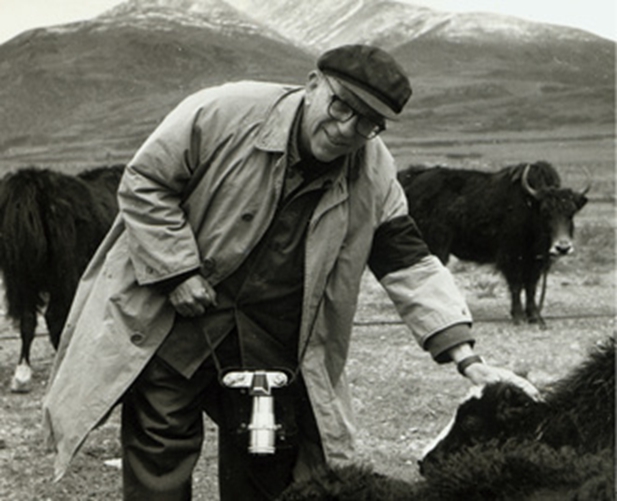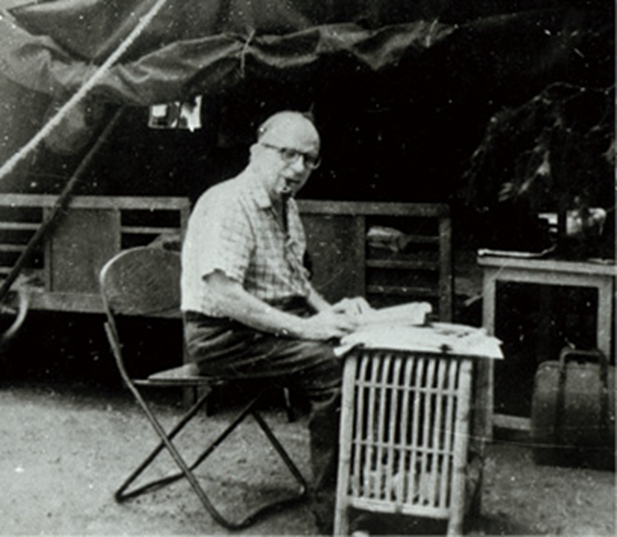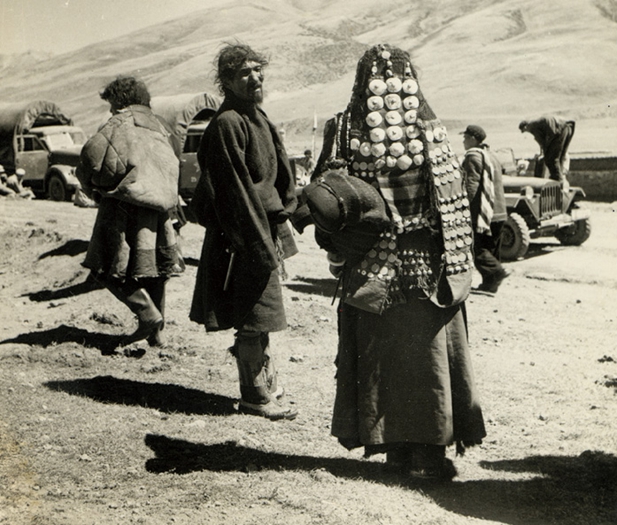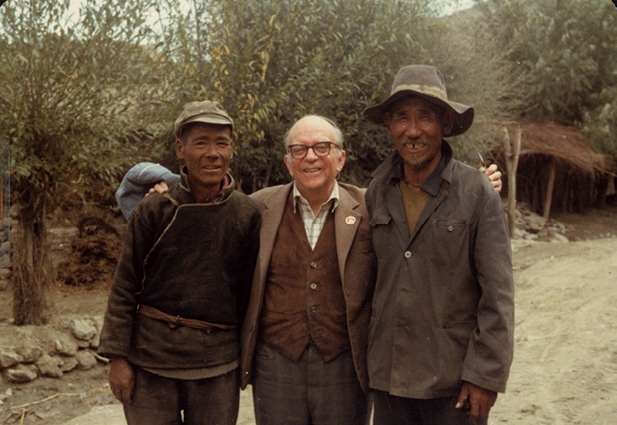I came upon Israel Epstein’s book Tibet Transformed in early 2014, the only one of his works without a Chinese edition. It mentioned Xizang Minzu University, where I work, several times which drew me closer to it. I therefore thought of translating the book into Chinese, so that more Chinese readers can learn of the tremendous changes in Tibet since the democratic reform (in 1959) and share the Tibetan people’s joy of a free, happy life under the leadership of the Communist Party of China (CPC).

Israel Epstein in Tibet
After receiving support from Huang Wanbi, Israel Epstein’s widow, I invited my colleagues Guo Yubin and Zheng Minfang to join me in the translation. The Chinese edition was published by New Star Press in 2015, the 100th anniversary of the birth of Epstein, and 50th anniversary of his first visit to Tibet. It all seems destined. The book may be the best celebration of the late journalist’s work.
Tibet Transformed records Epstein’s observation of changes in Tibet around the democratic reform, and is an important foreign-language work about the region in the early years of the People’s Republic of China. It is based on interviews Epstein made with hundreds of local people during three visits to Tibet -- in 1955, 1965, and 1976 respectively, during which he took notes of more than one million words. His writing and photos give an honest portrayal of the dramatic changes the democratic reform brought about in the region, and presents to readers a reborn Tibet in steady progress.
Comparisons are ubiquitous in the book. They throw in sharp contrast the old and new Tibet. In the beginning of Chapter Two, Epstein focuses on transport in the region.
“In 1955, the journey from Chengdu in Sichuan Province to Lhasa took a grinding twelve days by jeep and truck convoy. Even that seemed wonderfully speedy then. The spectacular and heroically built 2,412-kilometer roller-coaster highway had been recently completed and to tell the truth, intimidating. But historically, it represented hitherto undreamed-of progress. For thousands of years in the past, the only transport had been by yak or mule caravan – six months being considered good time for the trip. A friend who, traveled there in 1951 with a People’s Liberation Army unit with no slow marchers, took pride in his record of ‘only’ 104 days.”
“In 1965, we board a Chinese civil airlines plane in Chengdu, listened to the flight attendants’ routine announcements, munched on the sweets and fruit they dispensed, and were on Lhasa’s airfield in 2.5 hours.”
“By 1976 there were two scheduled air routes, from Chengdu and from Lanzhou in Gansu Province… There was a new airport closer to the city (Lhasa), at a lower altitude and better equipped than the one in 1965.”
From yak to jeep, from 12 days on road to two and half hours by air, these contrasts explained convincingly the all-round improvement in Tibet’s transport.

Israel Epstein writes his book Tibet Transformed at an earthquake shelter-tent of China International Publishing Group in 1976
Education is a barometer of social progress. In all his three visits to Tibet, Epstein came to Lhasa’s No.1 Primary School, and noticed the changes in student body and school facilities.
“In 1955 we met the school board. Of the 732 pupils in 1955, the school’s fourth year of existence, a third were from the families of nobles, but the rest were of other origins, including the oppressed poor among whom education had once been unknown and who still had very serious difficulties to contend with – despite state support. And more than half were girls.”
“In 1976, coming to this same school during the recess, we found seemingly countless youngsters noisily chasing footballs and leaping after basketballs in the spacious grounds. There were now 1,800 pupils of whom 1,007 were Tibetans, and 55 teachers of which 29 were Tibetans, and twice as many classrooms as before.”
By zooming in on one location and giving solid data about it, the author covers the undisputable progress in all aspects of the Tibetan society. Many more examples of contrasts in this book strongly underpin his argument about a Tibet transformed.
A big section of the book touches on the rekindled enthusiasm and passion for life among ordinary Tibetans. The democratic reform brought locals a life of happiness and freedom, and especially raised the social status of women. Epstein interviewed Tsering Lhamo, a local female official, in 1965 and again in 1976.
“When I first saw her in 1965, Tsering Lhamo was 39, and was already one of Tibet’s better known Communists, and Party secretary of the ‘Nangzan Mutual-Aid Team,’ a pioneer of the first stage of collective agriculture in Tibet … She seemed like, and was, a working woman to whom the liberation had restored the spring and bloom of youth, to whom the sufferings of the past had become a spur to tireless, awakened efforts in building the present and future. Vigorous of body, forthright in speech, with warm brown eyes and a ready smile frequently lighting up her clear-cut sun-browned face, she was an image of the freshly released potential of Tibet’s womanhood.”
“In 1976, I met her once more in her active, mature early fifties. She was by now a vice-chairman of the Tibet Autonomous Region, a member of its leading Party committee.”

Tibetan pastoral area photoed by Israel Epstein
In plain language, the author presents to readers a high-spirited, high-flying Tibetan woman who among millions of others in the region, were rebuilding Tibet with full drive and energy after being freed from serfdom. It’s easy to feel and understand their support and gratitude for the CPC.
Translation is no easy job, but rewarding. Sometimes one word or phrase demanded research of piles of documents. It was a learning process for me. The book is about China in the 1950s to 1970s, a period I, and also many readers, don’t have much knowledge of. Based on my research, I added notes for some terms associated with that particular piece of history. For instance, in the chapter about local industries, Epstein talked of the “July 21” college of Lhasa Farm Machinery Plant. I thought it necessary to give an explanation of this strangely named school. It started with Chairman Mao Zedong’s comments on a People’s Daily report on July 21, 1968, on preparation of factory technicians. He recommended that factories select workers and farmers with experience in practical work for study in vocational schools, and send them back to factory jobs a few years later. Following his instructions, factories all over China began to establish their own “July 21” colleges. Such kind of background information helps readers to better understand the book.
Tibet Transformed is an objective collection of what Epstein saw, heard, thought, and how he felt during his stay in the region. Most of the people he talked to were average people there, who told their own stories. Many were former serfs, including Nangsan, or house slaves (who were of the lowest caste, and deemed as talking livestock by their owners). To me, the principle Epstein followed in his introduction of Tibet to the outside world is to let the working people who had lived in both the old and new Tibet to speak themselves. Their accounts gave a vivid panoramic portrayal of their home region.

Israel Epstein and local Tibetan people
During the translation I was deeply impressed by the author’s affection for Tibetan people and local residents’ joy to start a new life and their heartfelt support to the CPC. Epstein made his stance clear in the book. In Chapter 24 Tibet’s State Schools, he wrote: “On July 23, 1965, the morning after arriving in Lhasa for the second time, I heard through my window a rustle and a medley of merry voices. It was the children, red scarved and apple-cheeked, going off to school along the freshly-asphalted People’s Road which stretched between rows of new white shops all the way from the gold-topped Jokhang Temple to the Potala.” The writing offers a glimpse of the delight of children of average families who for the first time in local history had the right to education.
Chapter 9 ‘The Accusers’ started with the line: “This chapter was hard to write, and will be hard to read, for it is like a descent into hell. But it ends well, because the inferno has ended.” In this section Epstein told stories of a tanner, Tashi, a herdsman, Sonam Tsering, and a tailor, Tenzing Wangchuk, and other Tibetans who suffered inhuman persecution before the liberation.
“It concerns seven men and a woman whom I met and interviewed in 1965… Of its eight living subjects, two had had their eyes gouged out. One had a leg tendon sundered, crippling him forever. One had his arm shot away. One had a hand chopped off and one a foot. One was deafened and disfigured and one barely escaped being ritually buried alive.”
As the author cautioned at the beginning of the chapter, these accounts are hard to read, like a descent into hell. But such poignancy singes the texts into readers’ minds. They are the author’s condemnation of serfdom in old Tibet and declaration of his political stance.
Tibet Transformed is a classic with high academic, educational, and literary values. It introduces to the rest of the world the tremendous changes sweeping all aspects of Tibet under the leadership of the CPC, including economy, politics, religion, military, education, and health care. It highlights the misery of the old Tibet and happiness in the new one, and disseminated China’s ethnic policy, hence contributing to national unity and ethnic solidarity.
I am honored and proud to be the translator of its Chinese edition.
_____________
GAO QUANXIAO is a professor with Xizang Minzu University.